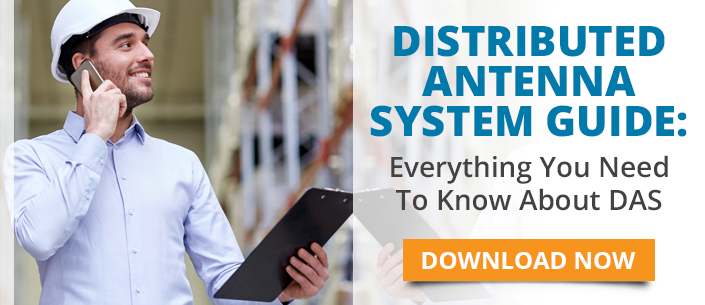 If you’re generally aware that a distributed antenna system can fix poor connectivity in your building but you aren’t quite clear about how the solution works, we’ve got a great whiteboard video that walks you through the process.
If you’re generally aware that a distributed antenna system can fix poor connectivity in your building but you aren’t quite clear about how the solution works, we’ve got a great whiteboard video that walks you through the process.
A distributed antenna system, also known as a DAS, is a highly effective way to instantly improve cell phone coverage and two-way radio range.
In just two minutes, the whiteboard video explains:
- What Distributed Antenna Systems Are
- Parts Contained in a Distributed Antenna System
- How DAS Solutions are Custom Built and Installed
What Distributed Antenna Systems Are
A distributed antenna system is a network of antennas both indoor and outdoor, along with bi-directional amplifiers, that amplifies the strength of your radio and commercial carrier signals and frequencies for more reliable in-building communications coverage.
A DAS functions by picking up the wireless signals that are coming into your building and delivering them to hard-to-access spots.
To ensure the DAS is effective, it’s important that the antennas are strategically placed, which is why it’s best to have the system professionally installed and adjusted occasionally.
Where DAS Works Best
A DAS is the preferred signal-boosting solution for several main categories of properties:
- Older structures or tunnels, particularly those made of reinforced concrete, brick or steel, including urban subway systems
- Buildings with the capacity to hold a large number of people at a time, such as school campus buildings, high-rise office buildings or hotels, airports, stadiums or factories
- Secluded locales surrounded by natural barriers like hills
- Any combination of the above
Parts Contained in a Distributed Antenna System
A DAS is made up of:
- Indoor and outdoor antennas
- Coaxial or fiber cabling
- Hybrid couplers
- Bi-directional amplifiers (BDAs)
The outdoor antennas capture signals that are redistributed by their indoor counterparts. The power dividers and hybrid couplers connect the antennas to the BDAs via cabling infrastructure. The BDAs then relay and amplify radio frequency, or RF, signals from private or commercial services.
How DAS Solutions are Custom Built and Installed
To function optimally, DAS solutions should be custom designed and built based on the specific building, location, and business or agency. The first step is to analyze the current two-way radio or commercial carrier system in the building, including the bands and frequencies, as well as the areas of coverage.
Distributed antenna systems are flexible enough to be outfitted for “the smallest office or the largest hospital.” And while they’re most commonly used for cellular carriers and public safety, they can be tailored for any businesses’ in-building communications needs.
In other words: No more “can you hear me now?”
DAS Use Case: Merchandise Mart in Chicago
In an article about how to boost cell phone coverage, Buildings magazine details the DAS installation at the Merchandise Mart in Chicago, a 4.2 million-square-foot behemoth that was built in the 1930s and houses up to 50,000 people at a time during trade shows. The Mart is so large, in fact, that it occupies its own zip code.
The DAS solution at Merchandise Mart requires a 2,000-square-foot space and is located on the northwest turret of the building’s 18th floor.
DAS vs. Signal Booster
If you’re battling cell phone dead zones or unreliable two-way radio coverage, you may be considering either a DAS or a signal booster as the solution.
Both of these in-building connectivity solutions have their pros and cons, and as you’re considering your options, here are some questions to keep in mind.
How large is the area you’re trying to cover?
Given its power and scope, a distributed antenna system is the go-to solution for large-scale footprints such as campuses, arenas, hospitals, airports, and subway systems.
Signal boosters have more limited power capabilities and may be a better option if you need a little less oomph or need to cover a smaller area, such as a single business within a larger facility.
Are you ready to work with a professional installer?
No matter which option you choose, you should be prepared to work with a trained and experienced installer to set up your system.
Particularly for a DAS, placement of the solution’s components is key, as is ongoing maintenance. Signal boosters are billed as a “plug and play” solution, but that doesn’t mean that just anyone should install them.
Proper placement for both is also key to avoiding signal interference.
DAS Explained
To figure out the right solution for your facility, contact Chicago Communications and request a free consultation with one of our DAS experts.



